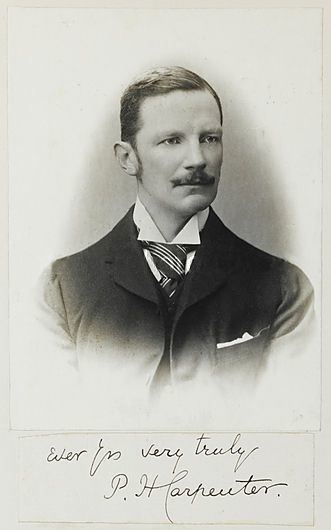Nationality British Grandparents Lant Carpenter | Name Philip Carpenter Years active 1874–1891 | |
 | ||
Born 6 February 1852 ( 1852-02-06 ) London, England Cause of death due to self-administration of chloroform during a bout of temporary insanity caused by chronic insomnia Resting place 51°34′01″N 0°08′49″E / 51.567°N 0.147°E / 51.567; 0.147 Parents William Benjamin Carpenter Similar People William Benjamin Carpenter, Lant Carpenter, Mary Carpenter | ||
Philip Herbert Carpenter (6 February 1852 in London – 21 October 1891 in Eton College), MA, D.Sc., FRS, British naturalist and crinoid authority, was the fourth son of Dr. William Benjamin Carpenter. He took his own life, by self-administration of chloroform during a bout of temporary insanity caused by chronic insomnia.
Contents
Education and research
Carpenter was educated at University College School, then at University College, and afterwards became a Scholar of Trinity College, Cambridge, where he graduated in 1874. He was a member of the scientific staff of the deep-sea exploring expeditions of H.M.S. Lightning (1868) and Porcupine (1869–1870). In 1875, he was appointed assistant naturalist to H.M.S. Valorous accompanying Admiral Sir George Strong Nares's Arctic expedition to Disco Island, and spent the summer sounding and dredging in Davis Strait and the North Atlantic.
Career
After the 1872–1876 HMS Challenger expedition had returned, he was asked in January 1878 by Sir Wyville Thomson to describe the free-swimming Crinoids that had been collected.
Dr. Carpenter was an expert on the morphology of the echinoderms, especially the crinoids, both contemporary and fossil. In 1883, he was awarded the Lyell Fund by the Geological Society of London in recognition of the scientific value of his work, and in 1885 was elected a Fellow of the Royal Society.
Publications
Carpenter published a large number of papers on Echinoderm and especially Crinoid morphology, in the Royal, Linnean, Geological, and Zoological Societies of London, the Quarterly Journal of Microscopical Science, the Annals and Magazine of Natural History, Zoologischer Anzeiger, and many other journals. He jointly authored the Catalogue of the Blastoidea in the British Museum with Mr. R. Etheridge, jun.
He also contributed an account of the Echinoderms to Cassell's Natural History (1883), and was the chief contributor for the section on the same group in Nicholson and Lydekker's A Manual of Palaeontology (1889).
Family
On 19 April 1879, he married Caroline Emma Hale, daughter of Edward Hale, an assistant master at Eton, by whom he had five sons, all surviving him.
